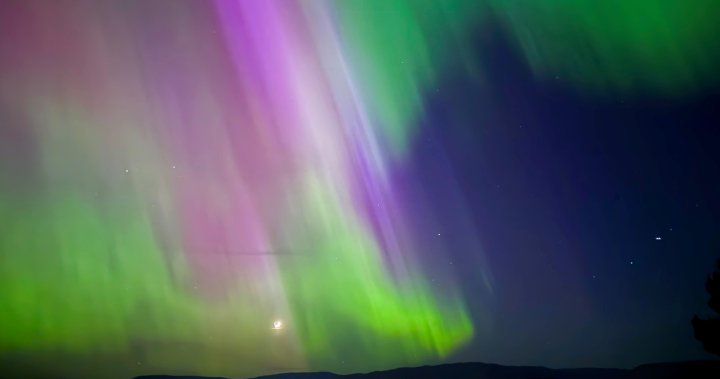The recent occurrence of a powerful geomagnetic storm in British Columbia led to a stunning display of the northern lights in the skies. Viewers described the spectacle as resembling a painting, with hues of blue, green, and purple dancing and changing throughout the night. The charged particles responsible for this light show are the result of solar flares and coronal mass ejections, with a large cluster on the sun being particularly active at this time. The National Oceanic and Atmospheric Administration issued a severe geomagnetic storm watch, the first since 2005, due to the potential impact of solar activity on Earth.
Solar flares and coronal mass ejections are powerful bursts of energy that can affect various systems on Earth, such as radio communications, power grids, and navigation signals. The ongoing activity on the sun poses a threat until the large and magnetically complex sunspot responsible for it rotates out of view in the coming days. To learn more about the northern lights, also known as the aurora borealis, interested individuals can visit the NOAA’s webpage for tips on viewing this natural phenomenon.
The northern lights are a natural phenomenon that occur when energized particles from the sun interact with Earth’s atmosphere, resulting in breathtaking displays of light in the night sky. The recent geomagnetic storm in British Columbia provided a rare opportunity for viewers to witness this spectacle, with the potential for the phenomenon to continue over the weekend. The beauty and awe inspired by the northern lights serve as a reminder of the wonders of nature and the interconnectedness of Earth and the sun.
In addition to the visual splendor of the northern lights, the recent geomagnetic storm highlighted the potential impacts of solar activity on Earth’s technological systems. Solar flares and coronal mass ejections can disrupt radio communications, power grids, and navigation signals, underscoring the importance of monitoring and understanding space weather phenomena. The NOAA’s issuance of a severe geomagnetic storm watch serves as a reminder of the need for preparedness and awareness when it comes to potential solar disturbances.
As the active sunspot responsible for the recent solar activity rotates out of view in the coming days, the threat of additional strong flares and coronal mass ejections is expected to diminish. However, the unpredictability of solar activity underscores the importance of ongoing monitoring and research to better understand and predict space weather events. By studying phenomena like the northern lights and their relationship to solar activity, scientists and researchers can gain insights into the dynamics of Earth’s magnetosphere and the impact of solar events on our planet.
In conclusion, the recent display of the northern lights in British Columbia serves as a reminder of the beauty and power of nature, as well as the potential impacts of solar activity on Earth. The stunning light show provided a rare opportunity for viewers to witness this natural phenomenon, while also highlighting the need for vigilance in monitoring space weather events. By studying the northern lights and other space weather phenomena, researchers can further our understanding of the complex interactions between the sun and Earth’s atmosphere, ultimately contributing to improved forecasting and preparedness for future solar disturbances.


